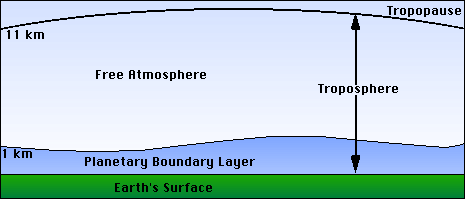

But what is a boundary layer? It turns out that there is a well defined, but quite variable height, where the influence of friction stops. Below this point, the earth's surface has direct influences on motion in the atmosphere. These influences include frictional drag, evapotranspiration, terrain induced flow modification, heat and energy transfer, and pollution emission. The PBL is that layer which is influenced directly by the earth's surface. Much of the weather we feel and see is a result of changes in the PBL. It is the layer that dissipates the energy from the upper atmosphere. Geostrophic winds above the PBL are often greater then 50 kts (58 mph). If those winds were prevalent at the earth's surface, it would be like having a tropical storm everywhere. Through friction and turbulence in the PBL, the energy in the free atmosphere is dissipated in the throughout the PBL. Below is a comparison of characteristics between the PBL and the free atmosphere. Next, we look at the structure of the PBL.
| Property | Planetary Boundary Layer | Free Atmosphere |
|---|---|---|
| Friction | Significant drag against earth's surface. High energy dissipation (due to friction) | Insignificant drag. Little energy dissipation (due to lack of friction). |
| Turbulence | Continuous turbulence throughout layer. | Turbulence only in convective clouds and near jet stream. |
| Thickness | Between 100 and 3000 m, diurnal variation over land | Between 8 and 18 km, little variation. Between PBL and tropopause. |
| Mixing | Rapid turbulent mixing in vertical and horizontal | Rapid horizontal mixing, a little molecular diffusion. |
 The Shodor
Education Foundation, Inc.
The Shodor
Education Foundation, Inc.